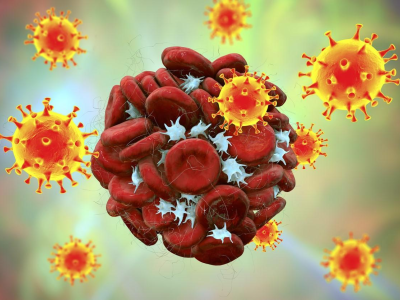California's valley fever hospitalization rate doubled from 2000 to 2011
The rate of hospitalizations for coccidioidomycosis, or valley fever, in California doubled from 2000 to 2011, and close to 16,000 patients needed hospital care for the fungal disease during that span, according to a report today by California public health officials.
Writing in Emerging Infectious Diseases, a team from the California Department of Public Health said that the hospitalization rate for valley fever increased from 2.3 initial admissions per 100,000 people in 2000 to 5.0 per 100,000 in 2011. They cite previous findings that the overall rate of cases in California increased six-fold from 2000 to 2011, from 2.4 to 14.4 per 100,000 people.
The authors counted 25,217 hospitalizations involving 15,747 patients during the 12 years, resulting in more than $2 billion in hospital charges. The number of hospitalizations increased from 1,074 in 2000 to 3,197 in 2011.
The team found that initial hospitalization rates were substantially higher for men than women, African Americans and Hispanics than whites, and older persons than younger persons, which accords with previous findings about groups at risk for severe disease.
Valley fever is caused by inhaling Coccidioides fungi spores, found in soil in the US Southwest. The report notes that most valley fever cases are asymptomatic, but symptoms occur in about 40% of infections and can range from a self-limited influenza-like illness to disseminated disease and chronic meningitis.
"In California, the increasing health- and cost-related effects of coccidioidomycosis-associated hospitalizations are a major public health challenge," the authors conclude.
Sep 16 Emerg Infect Dis report
Two H1N1v cases detected in Arkansas
Health officials in Arkansas recently reported two cases of variant H1N1 (H1N1v) influenza in people who had contact with pigs. Both patients have recovered, and contact monitoring has turned up no other cases, according to a Sep 13 statement from the Arkansas Department of Health (ADH).
Dirk Haselow, MD, PhD, state epidemiologist, said in the statement that the close surveillance of suspected influenza cases and close collaboration with the veterinary community helped identify the two cases, which have been confirmed by the US Centers for Disease Control and Prevention (CDC). He said animal flu virus variants are detected in humans a few times a year and typically cause only mild illness, but unlike seasonal flu don't spread easily from person to person.
The state will continue to monitor the situation and is aggressively looking for new cases, but so far health officials don't anticipate making any new public health recommendations about exposure to swine, he said.
Triple reassortant H1N1 viruses have circulated in US pigs since the 1990s, and the CDC classifies the sporadic detection in humans as variant viruses, according to background information from the CDC. In late 2011 health officials detected a swine H1N1 triple reassortant containing the matrix (M) gene from the 2009 H1N1 virus in a Wisconsin resident who had occupational contact with swine.
The two new H1N1v infections from Arkansas push the nation's cases of variant swine-origin flu to 16, according to the CDC.
Sep 13 ADH statement
Dec 23, 2011, CDC background
CDC variant influenza infections since 2005
FAO sounds H7N9, H5N1 warning ahead of flu season
The United Nations Food and Agriculture Organization (FAO) today warned the global community that H7N9 and H5N1 avian influenza viruses still pose serious threats to animal and human health, especially in light of the upcoming Northern Hemisphere flu season.
Juan Lubroth, DVM, PhD, the FAO's chief veterinary officer, said in a statement, "The world is more prepared than ever before to respond to bird flu in light of a decade of work on H5N1 and the recent response to H7N9. However, constant vigilance is required."
He made the comments as part of a joint meeting in Rome with the United States Agency for International Development (USAID), the World Health Organization (WHO), and the World Organization for Animal Health (OIE). Lubroth urged affected countries, along with neighboring nations and trade partners, to strengthen efforts to detect avian flu viruses, especially H7N9, because it is doesn't cause clinical signs in birds and is thus hard to detect.
To boost H7N9 response efforts, the FAO said it has committed $2 million in emergency funding, which is supplemented by more than $5 million from USAID. Lubroth noted that several at-risk countries can now accurately detect H7N9. "Identifying the virus with consistency is critical to targeting control efforts and reducing spread."
The FAO and USAID said further short-term efforts are needed, including targeted surveillance and trace-back through the production and marketing system, contingency planning, and compensation system development. Lubroth added that long-term steps should include urging countries to invest in improving poultry marketing and sales. "Restructuring can create healthier, safer markets by developing facilities that employ proper food safety and hygiene measures," he said.
The source of the new H7N9 virus in China is thought to be poultry, and so far the outbreak has sickened 135 people and killed 44. Most of the illnesses occurred in April and May, and while the pace has dropped off to sporadic detections over the summer, health officials have said activity might pick up when cooler temperatures return.
Sep 16 FAO statement
NIH study establishes minimum H1N1 infectious dose
A small National Institutes of Health (NIH) study of healthy adults who volunteered to be infected with the 2009 H1N1 (pH1N1) influenza virus has indicated the minimum infectious viral load necessary to produce mild-to-moderate illness, according to a presentation of the data last week.
In the study, 46 volunteers were divided into five groups and exposed to influenza virus in escalating doses, according to researchers who spoke at the Interscience Conference on Antimicrobial Agents and Chemotherapy (ICAAC) meeting in Denver.
Study participants were then admitted to an isolation unit at the NIH Clinical Center in Bethesda, Md., for at least 8 days. The volunteers' health was closely monitored while at the clinic and for 2 months afterward.
When 13 volunteers received via the nose a pH1N1 dose of 10 million of what is called 50% tissue culture infectious dose (or TCID50, which is the amount of inoculated virus needed to kill 50% of cultured cells), 9 of them (69%) shed virus and developed symptoms. Lower doses did not generate equivalent responses.
Sep 12 ICAAC abstract
Sep 13 NIH press release










